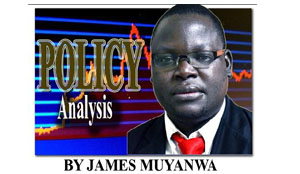 TO CONTINUE with last week’s topic on bonds and derivatives markets, I would like to start with an e-mail which I received from a reader during the week.
TO CONTINUE with last week’s topic on bonds and derivatives markets, I would like to start with an e-mail which I received from a reader during the week.
Joshua Tembo writes:
“Hi james,
“I read your article on bonds and derivatives exchange and I look forward to the next article.
“Do you think Zambia is ready to deal in this type of market? I say so because we have struggled to develop and grow the Zambian capital market for 20 years; liquidity and size are still an issue even up to now.
“Will the brokers registered with LuSE (Lusaka Stock Exchange) qualify to trade in this market? They already have the platform!
“Regards, Joshua”
I forwarded the mail to Bond and Derivatives Exchange Zambia Plc (BaDEx) deputy chief executive officer, Peter Sitamulaho who sent the following response:
“Dear James,
“Thanks for the feedback.
“1.Is Zambia ready for the market?
“We can answer this question by asking a few questions?
“Are Zambian entrepreneurs significantly exposed to foreign Exchange Markets and by extension affected by volatility in the forex markets?
“If the answer is yes to the question above, then we need to establish whether the Zambian Kwacha is usually the stronger currency or is the weaker currency compared to the other currencies such as the ZAR
(South African Rand) , USD (United States Dollar), Euro and GBP (Great British Pound).
“If the Zambian currency historically is weak against the above currencies, then we can agree that Zambian entrepreneurs and consumers are negatively impacted over the long term.
“But before we conclude we need to ask another question, if Zambians are negatively affected in the long terms as they are exposed to the foreign exchange market, the question then becomes do the Zambian entrepreneurs and consumers have access to protection against this negative impact?
“If the answer is NO, then the Bond and Derivatives Exchange is a timely intervention.
“2.The size of the Zambian Capital Markets and the lack of liquidity.
“I am the first to admit that the Capital Markets have not grown for the last 20 years.
“There are various reasons for this which I cannot go through them now but just to say that the capital markets participants are in the process of rectifying some of the structural issues and impediments to the growth of the capital markets.
“3.Will the brokers be allowed to trade on this market? Yes if they apply to trade on the BaDEx market they will. The two markets are not linked.
“4.Why will they trade on BaDEx if they have a platform already?
“Because the two markets do not offer the same products! And also one market can be used to invest and the other market to hedge (protect) the investment.
“Kind Regards, Peter K Sitamulaho.”
As promised I now want to look at some specific exchange-traded futures and explore some of the end-users of these products like the hedgers, speculators and investors.
According to Mr Sitamulaho, currency futures can be used to hedge against currency risks like the weakening of the Kwacha against the United States (US) dollar.
Let us, for instance, say firm A wants to buy 10 motor vehicles from Japan in the next three months at a cost of US$6,000 each and has set aside K396,000 which is equivalent to $60,000 at current rate.
Given the current performance of the Kwacha against the dollar, the firm is likely to pay more for the same number of vehicles should the Kwacha fall to, for instance, K10 per dollar from the current K6.6 per
dollar.
Let us, hypothetically, assume that in the next three months the spot exchange rate is K10 per dollar, the company would now require K600,000 to purchase the same number and type of vehicles.
Therefore, it would be prudent to lock in the current exchange rate of about K6.6 by buying a Kwacha/dollar futures contract.
If this is done, the additional cost of acquiring the vehicles would be offset by the gain the firm would make from the futures contract.
The currency futures can also be used to speculate on the strengthening Kwacha, for instance.
Let us assume that you believe that the Kwacha will strengthen against the dollar and wish to enter into a trade to profit from such a movement.
You sell 10 currency future contracts at a trading price of K6.6 and you are exposed to $10,000 because each contract is worth $1000.
The value of your 10 contracts = K66,000 (K6.6 x 1000 x 10). You are only required to pay your initial margin deposit to gain this exposure.
A couple of weeks later the Kwacha strengthens and the futures trade at K5.6.
You close your position and make a profit of K10,000.
The primary risk management tools in the derivative market are Initial Margins (A good faith deposit), variation margin (daily profit and loss) and a guarantee fund.
The products that BaDex is currently offering are currency futures and options, based on the Zambian Kwacha to the USD, Euro, GBP and others.






